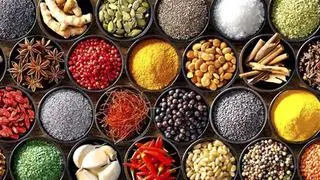Turmeric prices have climbed to a near 13-year high on fears of lower area under the crop this year and shortage of seeds in some regions for farmers to re-sow.
Traders fear prices could touch the 2010 high of ₹170 a kg or ₹1,70,000 a quintal in the spot market.
On Tuesday, turmeric October futures topped ₹13,000 a quintal to rise to ₹13,042 before settling at ₹12,832. In the spot market, the modal price (rates at which most trades take place) of the finger variety turmeric was quoted at ₹9,898 a quintal at Nizamabad agricultural produce marketing committee yard. In Maharashtra’s Nanded, too, the rates have soared to levels of ₹9,800.
Anu V Pai, Commodity research analyst at Geojit Financial Services, said, “amidst good export demand, fall in arrivals along with delay in sowing and unfavourable weather have propelled the rally in turmeric prices.”
Low supplies
AgriWatch seconded the view saying a firm sentiment is being observed in turmeric markets due to low supplies in major markets, besides fears of sowing being affected in key growing regions, slow sowing and good export demand.
Turmeric exports, which have picked up after the Covid pandemic, increased 11 per cent year on year to 1,70,085 tonnes in the 2022-23 fiscal. “There are two aspects to the rise in turmeric prices. There is a huge rainfall deficiency in Marathwada and Vidarbha regions of Maharashtra. The deficiency is nearly 50 per cent and if the El Nino factor comes into play, it could affect the acreage further,” said Ankit Agarwal, Director, Amar Agarwal Foods India Pvt Ltd, Erode.
Seed prices surge
Besides these two regions, Tamil Nadu, Telangana and Andhra Pradesh are also witnessing a drop in acreage due to lack of rains, said Amrtulal Kataria, a trader from Nizamabad.
Even if the monsoon makes up the deficiency, farmers in Maharashtra would find it difficult to re-sow as they are facing a seed shortage. “Seed prices have gone up three times in view of the shortage,” said Poonam Chand Gupta, another trader from Nizamabad.
“Farmers in Tamil Nadu and other southern States may be able to get the required seeds,” Agarwal said. “Currently, sowing is only 65-70 per cent of last year’s coverage,” Gupta said.
Interesting reason
Sowing activities in certain turmeric growing regions in Telangana, Tamil Nadu, Andhra Pradesh and Maharashtra have been progressing at a slower pace over the past few weeks compared to the previous season, AgriWatch said.
The research company has an interesting reason for the decrease in the area under turmeric. “The turmeric acreage is expected to decrease primarily due to farmers witnessing a lower realisation compared to other crops such as cotton and maize. Hence, farmers and stockists are less interested,” said Biplab Sarma, Senior Research Analyst - Commodities (Spices), AgriWatch.
AgriWatch expects the area under turmeric to decline 12 per cent compared to 1.75 lakh hectares last year. “The acreage may slip to 20 per cent, driving prices higher than in 2010, when they increased to ₹170 a kg,” Agarwal said.
It could turn out to be a good year for turmeric prices as they could gain sharply in the coming months.
Besides lower sowing in the current kharif season, the turmeric crop was affected by unseasonal rains in March. This affected the quality of the crop and as a result, quality turmeric has been in demand over the last couple of months, pushing up prices.








Comments
Comments have to be in English, and in full sentences. They cannot be abusive or personal. Please abide by our community guidelines for posting your comments.
We have migrated to a new commenting platform. If you are already a registered user of TheHindu Businessline and logged in, you may continue to engage with our articles. If you do not have an account please register and login to post comments. Users can access their older comments by logging into their accounts on Vuukle.